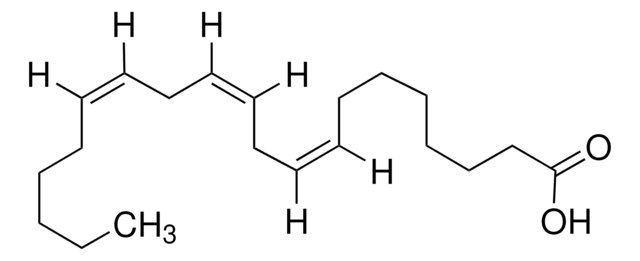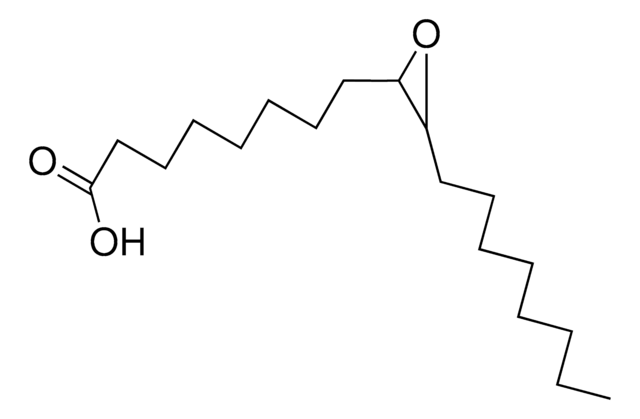Alle Fotos(1)
Wichtige Dokumente
E5641
11,12-Epoxy-(5Z,8Z,14Z)-eicosatrienoic acid
~100 μg/mL in ethanol, ≥95%
Synonym(e):
(±)11,12-EpETrE, 11,12-EET
Anmeldenzur Ansicht organisationsspezifischer und vertraglich vereinbarter Preise
Alle Fotos(1)
About This Item
Empirische Formel (Hill-System):
C20H32O3
CAS-Nummer:
Molekulargewicht:
320.47
EG-Nummer:
MDL-Nummer:
UNSPSC-Code:
12352211
PubChem Substanz-ID:
NACRES:
NA.25
Empfohlene Produkte
Qualitätsniveau
Assay
≥95%
Konzentration
~100 μg/mL in ethanol
Lipid-Typ
omega FAs
Lagertemp.
−20°C
SMILES String
CCCCC\C=C\CC1OC1C\C=C\C\C=C\CCCC(O)=O
InChI
1S/C20H32O3/c1-2-3-4-5-9-12-15-18-19(23-18)16-13-10-7-6-8-11-14-17-20(21)22/h6,8-10,12-13,18-19H,2-5,7,11,14-17H2,1H3,(H,21,22)/b8-6+,12-9+,13-10+
InChIKey
DXOYQVHGIODESM-ATELOPIESA-N
Verpackung
Packaged under argon
Signalwort
Danger
H-Sätze
Gefahreneinstufungen
Eye Irrit. 2 - Flam. Liq. 2
Lagerklassenschlüssel
3 - Flammable liquids
WGK
WGK 1
Flammpunkt (°F)
48.2 °F - closed cup
Flammpunkt (°C)
9 °C - closed cup
Hier finden Sie alle aktuellen Versionen:
Besitzen Sie dieses Produkt bereits?
In der Dokumentenbibliothek finden Sie die Dokumentation zu den Produkten, die Sie kürzlich erworben haben.
L Yang et al.
British journal of clinical pharmacology, 80(1), 28-44 (2015-02-07)
There is increasing evidence suggesting that epoxyeicosatrienoic acids (EETs) play an important role in cardioprotective mechanisms. These include regulating vascular tone, modulating inflammatory responses, improving cardiomyocyte function and reducing ischaemic damage, resulting in attenuation of animal models of cardiovascular risk
Yong Zhou et al.
Shock (Augusta, Ga.), 47(5), 638-645 (2016-10-19)
Acute lung injury (ALI) is characterized by rapid alveolar injury, vascular leakage, lung inflammation, neutrophil accumulation, and induced cytokines production leading to lung edema. The mortality rate of patients suffering from ALI remains high. Epoxyeicosatrienoic acids (EETs) are cytochrome P450-dependent
Huichen Zhao et al.
Laboratory investigation; a journal of technical methods and pathology, 97(7), 782-791 (2017-03-21)
Epoxyeicosatrienoic acids (EETs) are the epoxidation products of arachidonic acid catalyzed by cytochrome P450 (CYP) epoxygenases, which possess multiple biological activities. In the present study, we aimed to explore the role and effects of CYP epoxygenases/EETs in wound healing in
Yindi Ding et al.
The Journal of pharmacology and experimental therapeutics, 350(1), 14-21 (2014-04-26)
Cytochrome P450-derived epoxides of arachidonic acid [i.e., the epoxyeicosatrienoic acids (EETs)] are important lipid signaling molecules involved in the regulation of vascular tone and angiogenesis. Because many actions of 11,12-cis-epoxyeicosatrienoic acid (EET) are dependent on the activation of protein kinase
Jihong Lin et al.
Theranostics, 10(17), 7857-7871 (2020-07-21)
Rationale: Vasoregression secondary to glial activation develops in various retinal diseases, including retinal degeneration and diabetic retinopathy. Photoreceptor degeneration and subsequent retinal vasoregression, characterized by pericyte loss and acellular capillary formation in the absence diabetes, are also seen in transgenic
Unser Team von Wissenschaftlern verfügt über Erfahrung in allen Forschungsbereichen einschließlich Life Science, Materialwissenschaften, chemischer Synthese, Chromatographie, Analytik und vielen mehr..
Setzen Sie sich mit dem technischen Dienst in Verbindung.







